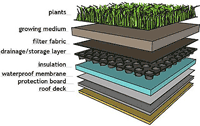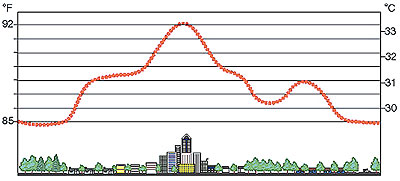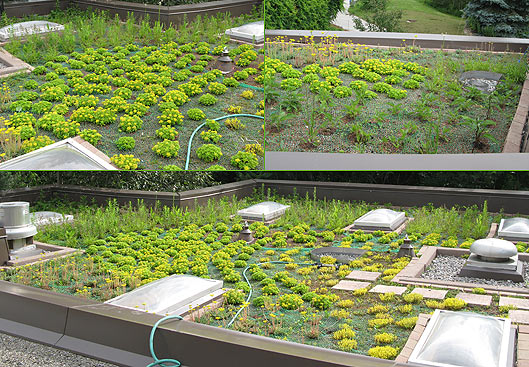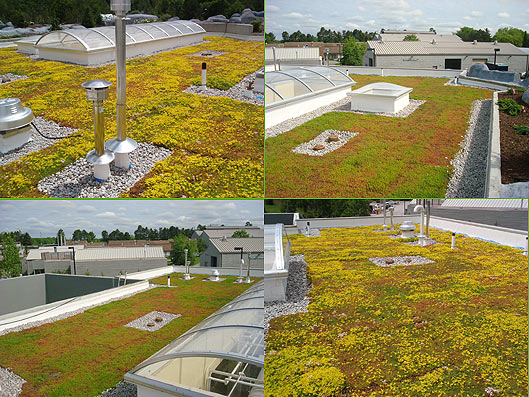Green Roofs
WHAT ARE GREEN ROOFS?
Green roofs, also known as 'living roofs' or 'eco-roofs', are the wave of the future in sustainable design, and the Toronto Zoo is surfin' right along with them! While the term 'green roof' could mean many things, it refers here to a roof with one or more extra membranes, including a waterproof and root-proof section that is covered by various types of vegetation. To the right is an illustration of the various layers that make up a green roof.
GREEN ROOF BENEFITS FOR ZOO AND VISITORS!
- It filters particles from the air and converts carbon dioxide into oxygen; 1.0 m2 (10.76 ft2) of uncut grass can remove 0.2 kg of particulates from the air and fulfill one person's oxygen requirements during one year!
- It cools air around the building and reduces the urban heat island effect. This effect, illustrated to the right, describes the phenomenon of cities being several degrees hotter than the surrounding countryside. This is because cities replace natural landscape with hard, impermeable surfaces. Recent studies have indicated that greening just 6% of the City of Toronto's rooftops could reduce summer temperatures by 1 - 2 degrees C, saving an estimated $1.0 million in energy costs per year!
- It provides insulation against sound and benefits both the animals in the Australasia Pavilion and their visitors. Australasia's green roof, with its 15 cm substrate layer, is expected to reduce incoming sound by 40-45 dBs.
- It contributes toward biodiversity by housing a variety of plant species and providing a stop-off point for local plants and animals.
- It retains stormwater for use by the plants, easing pressure on sewer infrastructure. In the summer, green roofs retain 70 - 80% of the precipitation that falls on them and in the winter between 25 - 40%.
- It provides educational opportunities and beautiful visual scenery. American and British studies show that "good tree cover" adds between 6 -15% to the value of a home.
- It provides opportunities for monetary rewards through tax credits, loans and grants.
- AND it lasts twice as long as a conventional roof!

The layers of a green roof; Image courtesy Green Garage - www.greengarage.ca

Urban Heat Island Effect; Photo courtesy Lawrence Berkeley National Laboratory
Australasia
In April 2008, the Toronto Zoo built a 111.5 m2 (1200 ft2) green roof system on the top of Australasia Pavilion. This green roof cools and clean the atmosphere, it provides habitat for birds and insects, helps combat climate change, and retains rainwater. The Australasia green roof also reduces energy consumption because it is a natural insulator!

Tundra
In August 2009 the Toronto Zoo built a 464.5 m2 (5000 ft2) green roof system on the new Tundra exhibit. This newly designed exhibit uses native plants to provide shade, and release water to stay cool in hot summer months. Green roofs are great for providing habitat for birds and insects, cooling and cleaning the atmosphere and fighting climate change!

Africa Savanna
The 127 m2 (1360 ft2) green roof on the Penguin Habitat retains and filters as much as 100,000 L of rainwater each year reducing the stress to the storm sewers during significant storm events.
Wildlife Health Centre
In May 2017, the Zoo’s new Wildlife Health Centre opened with 474 m2 (5100 ft2) of green roof covering 23 percent of its roof surface. This green roof creates valuable habitat for birds, pollinators and other insects, reduces heat loss and energy consumption in this new facility built to LEED Gold standards.
In the past 10 years, the Toronto Zoo has installed over 1178 m2 (13,600 ft2) of green roof. The Zoo will continue to actively install green roofs in our efforts to lessen our concrete footprint which helps support biodiversity, cleans the air, reduces the urban island heat effect of our facility, reduces our energy consumption and helps mitigate climate change.
HOW TO PLANT YOUR OWN GREEN ROOF!
Step 1: Approach your local municipality to obtain a grant or permission to build a green roof. The City of Toronto has recently established an incentive program to encourage green roof construction.
Step 2: Now that you got the go-ahead, you're ready for some tips! Green roofs are typically installed on flat roofs, but can be adapted for sloped roofs as well. They can be either "intensive," with about 30 cm of soil and a wide variety of plants, or "extensive," with about 8.5 cm of soil and a more limited selection of plants. Extensive green roofs are less expensive, lighter, and easier to maintain.
If you live in Toronto and would like to start a green roof, please click here
HOW TO GO GREEN WITHOUT A GREEN ROOF!
If you want to enjoy the benefits of a green roof but don't have the time, interest or money to invest in one, here are some helpful tips: Step 1: Provide habitat for wildlife by planting native species in your backyard, put out water and feeders, and leaving dead trees in your yard
Step 2: Reduce your own energy output, help clean the air around you and save money by replacing old appliances with new, more environmentally friendly ones. Turning off unused lights Reducing temperature at night or when you go away. Dressing warm in the winter and cool in the summer
Step 3: Start a rooftop garden or a pseudo-green roof simply by placing some potted plants on your roof or deck.
HOW TO BRING GREEN ROOFS TO YOUR COMMUNITY!
- Join a larger community project by searching green roof projects in your area at GreenRoofs.com.
- Ask building owners in your community to consider greening their rooftops and bring together a team of volunteers to establish a project. Sample letters are available at Greening Gotham.













